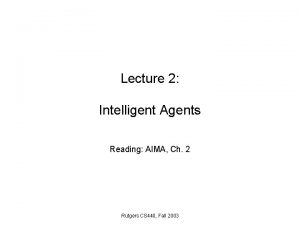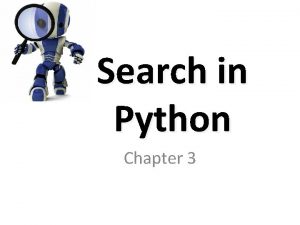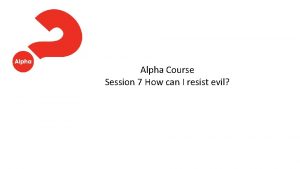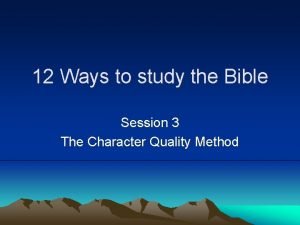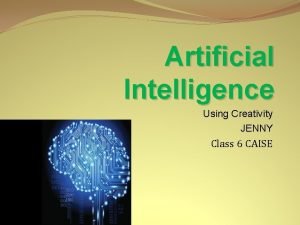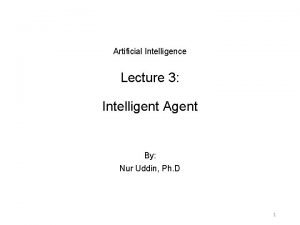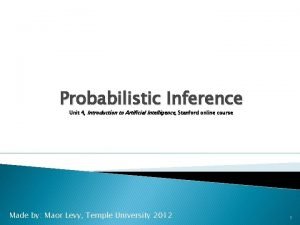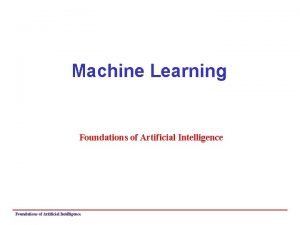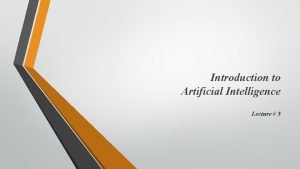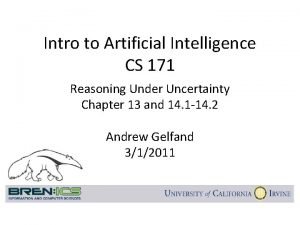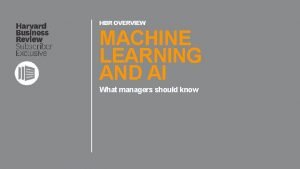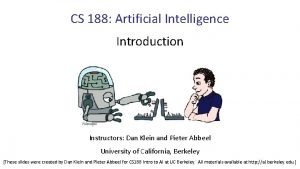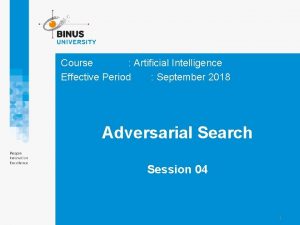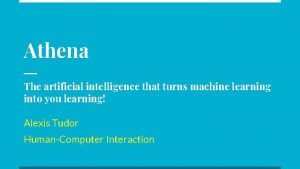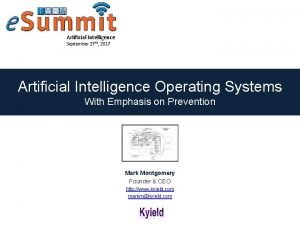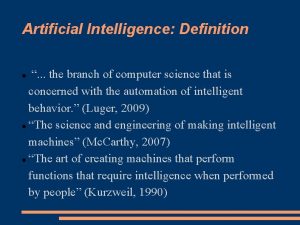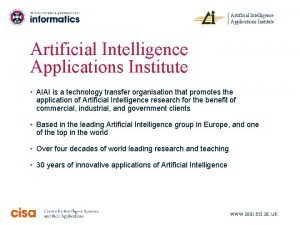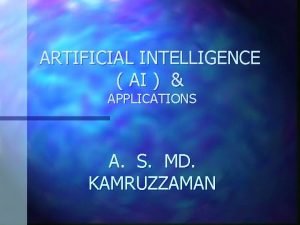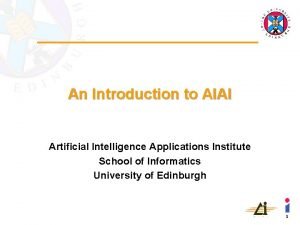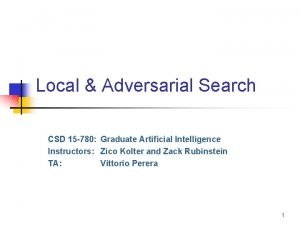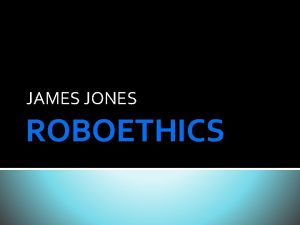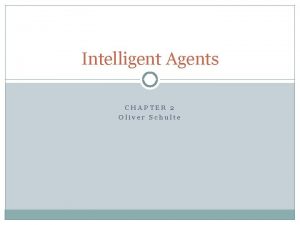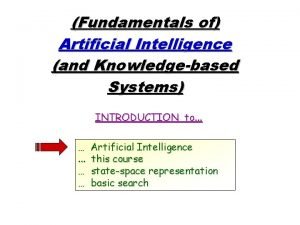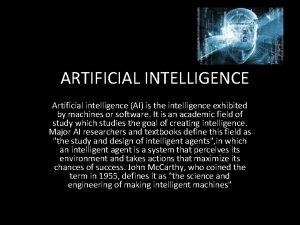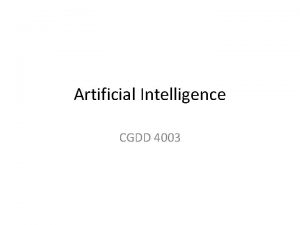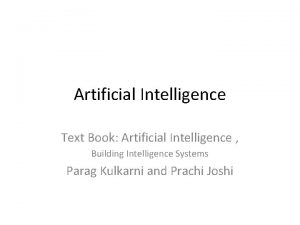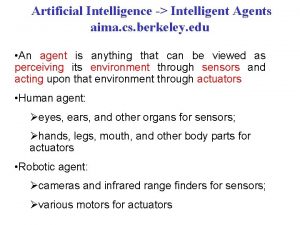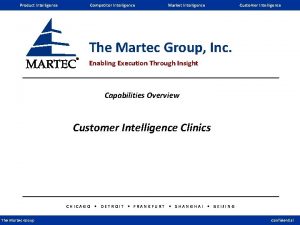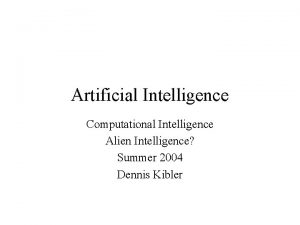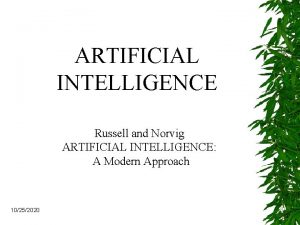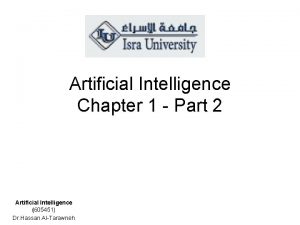Artificial Intelligence Session 1 Course material AIMA Artificial
![Artificial Intelligence (Session 1) • Course material: • [AIMA] Artificial Intelligence: A Modern Approach, Artificial Intelligence (Session 1) • Course material: • [AIMA] Artificial Intelligence: A Modern Approach,](https://slidetodoc.com/presentation_image_h/03167320cabd8d72813bdb38471bb1f1/image-1.jpg)





















![Course Overview General Introduction • 01 -Introduction. [AIMA Ch 1] Course Schedule. Homeworks, exams Course Overview General Introduction • 01 -Introduction. [AIMA Ch 1] Course Schedule. Homeworks, exams](https://slidetodoc.com/presentation_image_h/03167320cabd8d72813bdb38471bb1f1/image-23.jpg)








![Course Overview (cont. ) Expert Systems • 21 -Introduction to CLIPS. [handout] Overview of Course Overview (cont. ) Expert Systems • 21 -Introduction to CLIPS. [handout] Overview of](https://slidetodoc.com/presentation_image_h/03167320cabd8d72813bdb38471bb1f1/image-32.jpg)

![Course Overview (cont. ) AI with Neural networks • 24/25 -Neural Networks. [Handout] Introduction Course Overview (cont. ) AI with Neural networks • 24/25 -Neural Networks. [Handout] Introduction](https://slidetodoc.com/presentation_image_h/03167320cabd8d72813bdb38471bb1f1/image-34.jpg)
![Course Overview (cont. ) Evolving Intelligent Systems • 26 -Genetic Algorithms. [Handout] Introduction to Course Overview (cont. ) Evolving Intelligent Systems • 26 -Genetic Algorithms. [Handout] Introduction to](https://slidetodoc.com/presentation_image_h/03167320cabd8d72813bdb38471bb1f1/image-35.jpg)















- Slides: 50
![Artificial Intelligence Session 1 Course material AIMA Artificial Intelligence A Modern Approach Artificial Intelligence (Session 1) • Course material: • [AIMA] Artificial Intelligence: A Modern Approach,](https://slidetodoc.com/presentation_image_h/03167320cabd8d72813bdb38471bb1f1/image-1.jpg)
Artificial Intelligence (Session 1) • Course material: • [AIMA] Artificial Intelligence: A Modern Approach, by Stuart Russell and Peter Norvig. (2 nd ed) CS 460, Lecture 1

• Grading: 40% for midterm + 45% for final + 15% for mandatory homeworks/assignments CS 460, Lecture 1

Why study AI? Search engines Science Medicine/ Diagnosis Labor Appliances CS 460, Lecture 1 What else?

Honda Humanoid Robot Walk Turn http: //world. honda. com/robot/ CS 460, Lecture 1 Stairs

Sony AIBO http: //www. aibo. com CS 460, Lecture 1

Natural Language Question Answering http: //aimovie. warnerbros. com http: //www. ai. mit. edu/projects/infolab/ CS 460, Lecture 1

Robot Teams USC robotics Lab CS 460, Lecture 1

What is AI? The exciting new effort to make computers thinks … machine with minds, in the full and literal sense” (Haugeland 1985) “The study of mental faculties through the use of computational models” (Charniak et al. 1985) “The art of creating machines that perform functions that require intelligence when performed by people” (Kurzweil, 1990) A field of study that seeks to explain and emulate intelligent behavior in terms of computational processes” (Schalkol, 1990) Systems that think like humans Systems that think rationally Systems that act like humans Systems that act rationally CS 460, Lecture 1

Acting Humanly: The Turing Test • Alan Turing's 1950 article Computing Machinery and Intelligence discussed conditions for considering a machine to be intelligent • “Can machines think? ” “Can machines behave intelligently? ” • The Turing test (The Imitation Game): Operational definition of intelligence. CS 460, Lecture 1

Acting Humanly: The Turing Test • Computer needs to possess: Natural language processing, Knowledge representation, Automated reasoning, and Machine learning • Are there any problems/limitations to the Turing Test? CS 460, Lecture 1

What tasks require AI? • “AI is the science and engineering of making intelligent machines which can perform tasks that require intelligence when performed by humans …” • What tasks require AI? CS 460, Lecture 1

What tasks require AI? • Tasks that require AI: • • Solving a differential equation Brain surgery Inventing stuff What about walking? What about grabbing stuff? What about pulling your hand away from fire? What about watching TV? What about day dreaming? CS 460, Lecture 1

Acting Humanly: The Full Turing Test • Alan Turing's 1950 article Computing Machinery and Intelligence discussed conditions for considering a machine to be intelligent • “Can machines think? ” “Can machines behave intelligently? ” • The Turing test (The Imitation Game): Operational definition of intelligence. • Computer needs to posses: Natural language processing, Knowledge • Problem: 1) Turing test is not reproducible, constructive, and amenable to • Total Turing Test: Requires physical interaction and needs perception and representation, Automated reasoning, and Machine learning mathematic analysis. 2) What about physical interaction with interrogator and environment? actuation. CS 460, Lecture 1

Acting Humanly: The Full Turing Test • Problem: 1) Turing test is not reproducible, constructive, and amenable to mathematic analysis. 2) What about physical interaction with interrogator and environment? CS 460, Lecture 1

Acting Humanly: The Full Turing Test Problem: 1) Turing test is not reproducible, constructive, and amenable to mathematic analysis. 2) What about physical interaction with interrogator and environment? Trap door CS 460, Lecture 1

What would a computer need to pass the Turing test? • Natural language processing: to communicate with examiner. • Knowledge representation: to store and retrieve information provided before or during interrogation. • Automated reasoning: to use the stored information to answer questions and to draw new conclusions. • Machine learning: to adapt to new circumstances and to detect and extrapolate patterns. CS 460, Lecture 1

What would a computer need to pass the Turing test? • Vision (for Total Turing test): to recognize the examiner’s actions and various objects presented by the examiner. • Motor control (total test): to act upon objects as requested. • Other senses (total test): such as audition, smell, touch, etc. CS 460, Lecture 1

How to achieve AI? • How is AI research done? • AI research has both theoretical and experimental sides. The experimental side has both basic and applied aspects. • There are two main lines of research: • One is biological, based on the idea that since humans are intelligent, AI should study humans and imitate their psychology or physiology. • The other is phenomenal, based on studying and formalizing common sense facts about the world and the problems that the world presents to the achievement of goals. • The two approaches interact to some extent, and both should eventually succeed. It is a race, but both racers seem to be walking. [John Mc. Carthy] CS 460, Lecture 1

Branches of AI • • • • Logical AI Search Natural language processing pattern recognition Knowledge representation Inference From some facts, others can be inferred. Automated reasoning Learning from experience Planning To generate a strategy for achieving some goal Epistemology Study of the kinds of knowledge that are required for solving problems in the world. Ontology Study of the kinds of things that exist. In AI, the programs and sentences deal with various kinds of objects, and we study what these kinds are and what their basic properties are. Genetic programming Emotions? ? ? … CS 460, Lecture 1

AI Prehistory CS 460, Lecture 1

AI History CS 460, Lecture 1

AI State of the art • Have the following been achieved by AI? • • • World-class chess playing Playing table tennis Cross-country driving Solving mathematical problems Discover and prove mathematical theories Engage in a meaningful conversation Understand spoken language Observe and understand human emotions Express emotions … CS 460, Lecture 1
![Course Overview General Introduction 01 Introduction AIMA Ch 1 Course Schedule Homeworks exams Course Overview General Introduction • 01 -Introduction. [AIMA Ch 1] Course Schedule. Homeworks, exams](https://slidetodoc.com/presentation_image_h/03167320cabd8d72813bdb38471bb1f1/image-23.jpg)
Course Overview General Introduction • 01 -Introduction. [AIMA Ch 1] Course Schedule. Homeworks, exams and • 02 -Intelligent Agents. [AIMA Ch 2] What is grading. Course material, TAs and office hours. Why study AI? What is AI? The Turing test. Rationality. Branches of AI. Research disciplines connected to and at the foundation of AI. Brief history of AI. Challenges for the future. Overview of class syllabus. effectors CS 460, Lecture 1 sensors an intelligent agent? Examples. Doing the right thing (rational action). Performance measure. Autonomy. Environment and agent design. Structure of agents. Agent types. Reflex agents. Reactive agents. Reflex agents with state. Goal-based agents. Utility-based agents. Mobile agents. Information agents. Agent

Course Overview (cont. ) How can we solve complex problems? • 03/04 -Problem solving and search. [AIMA Ch 3] Example: measuring problem. Types of problems. More example problems. Basic idea behind search algorithms. Complexity. Combinatorial explosion and NP completeness. Polynomial hierarchy. • 05 -Uninformed search. [AIMA Ch 3] Depth-first. • 06/07 -Informed search. [AIMA Ch 4] Best-first. 3 l 5 l 9 l Using these 3 buckets, measure 7 liters of water. Breadth-first. Uniform-cost. Depth-limited. Iterative deepening. Examples. Properties. A* search. Heuristics. Hill climbing. Problem of local extrema. Simulated annealing. CS 460, Lecture 1 Traveling salesperson problem

Course Overview (cont. ) Practical applications of search. • 08/09 -Game playing. [AIMA Ch 5] The minimax algorithm. Resource limitations. Aplha-beta pruning. Elements of chance and nondeterministic games. tic-tac-toe CS 460, Lecture 1

Course Overview (cont. ) Towards intelligent agents • 10 -Agents that reason logically 1. [AIMA Ch 6] Knowledge-based agents. Logic and representation. Propositional (boolean) logic. • 11 -Agents that reason logically 2. [AIMA Ch 6] Inference in propositional logic. Syntax. Semantics. Examples. wumpus world CS 460, Lecture 1

Course Overview (cont. ) Building knowledge-based agents: 1 st Order Logic • 12 -First-order logic 1. [AIMA Ch 7] Syntax. Semantics. Atomic sentences. Complex sentences. Quantifiers. Examples. FOL knowledge base. Situation calculus. • 13 -First-order logic 2. [AIMA Ch 7] Describing actions. Planning. Action sequences. CS 460, Lecture 1

Course Overview (cont. ) Representing and Organizing Knowledge • 14/15 -Building a knowledge base. [AIMA Ch 8] Knowledge bases. Vocabulary and rules. Ontologies. Organizing knowledge. Kahn & Mcleod, 2000 An ontology for the sports domain CS 460, Lecture 1

Course Overview (cont. ) Reasoning Logically • 16/17/18 -Inference in first-order logic. [AIMA Ch 9] Proofs. Unification. Generalized modus ponens. Forward and backward chaining. Example of backward chaining CS 460, Lecture 1

Course Overview (cont. ) Examples of Logical Reasoning Systems • 19 -Logical reasoning systems. [AIMA Ch 10] Indexing, retrieval and unification. The Prolog language. Theorem provers. Frame systems and semantic networks. Semantic network used in an insight generator (Duke university) CS 460, Lecture 1

Course Overview (cont. ) Systems that can Plan Future Behavior • 20 -Planning. [AIMA Ch 11] Definition and goals. Basic representations for planning. Situation space and plan space. Examples. CS 460, Lecture 1
![Course Overview cont Expert Systems 21 Introduction to CLIPS handout Overview of Course Overview (cont. ) Expert Systems • 21 -Introduction to CLIPS. [handout] Overview of](https://slidetodoc.com/presentation_image_h/03167320cabd8d72813bdb38471bb1f1/image-32.jpg)
Course Overview (cont. ) Expert Systems • 21 -Introduction to CLIPS. [handout] Overview of modern rule-based expert systems. Introduction to CLIPS (C Language Integrated Production System). Rules. Wildcards. Pattern matching. Pattern network. Join network. CS 460, Lecture 1 CLIPS expert system shell

Course Overview (cont. ) Logical Reasoning in the Presence of Uncertainty • 22/23 -Fuzzy logic. [Handout] Introduction to fuzzy logic. Linguistic Hedges. Fuzzy inference. Examples. Center of gravity Center of largest area CS 460, Lecture 1
![Course Overview cont AI with Neural networks 2425 Neural Networks Handout Introduction Course Overview (cont. ) AI with Neural networks • 24/25 -Neural Networks. [Handout] Introduction](https://slidetodoc.com/presentation_image_h/03167320cabd8d72813bdb38471bb1f1/image-34.jpg)
Course Overview (cont. ) AI with Neural networks • 24/25 -Neural Networks. [Handout] Introduction to perceptrons, Hopfield networks, self-organizing feature maps. How to size a network? What can neural networks achieve? CS 460, Lecture 1
![Course Overview cont Evolving Intelligent Systems 26 Genetic Algorithms Handout Introduction to Course Overview (cont. ) Evolving Intelligent Systems • 26 -Genetic Algorithms. [Handout] Introduction to](https://slidetodoc.com/presentation_image_h/03167320cabd8d72813bdb38471bb1f1/image-35.jpg)
Course Overview (cont. ) Evolving Intelligent Systems • 26 -Genetic Algorithms. [Handout] Introduction to genetic algorithms and their use in optimization problems. CS 460, Lecture 1

Course Overview (cont. ) What challenges remain? • 27 -Towards intelligent machines. [AIMA Ch 25] The challenge of robots: with what we have learned, what hard problems remain to be solved? Different types of robots. Tasks that robots are for. Parts of robots. Architectures. Configuration spaces. Navigation and motion planning. Towards highly-capable robots. • 28 -Overview and summary. [all of the above] What have we learned. Where do we go from here? CS 460, Lecture 1 robotics@USC

A driving example: Beobots • Goal: build robots that can operate in unconstrained environments and that can solve a wide variety of tasks. CS 460, Lecture 1

Beowulf + robot = “Beobot” CS 460, Lecture 1

A driving example: Beobots • Goal: build robots that can operate in unconstrained environments and that can solve a wide variety of tasks. • We have: • • • Lots of CPU power Prototype robotics platform Visual system to find interesting objects in the world Visual system to recognize/identify some of these objects Visual system to know the type of scenery the robot is in • We need to: • Build an internal representation of the world • Understand what the user wants • Act upon user requests / solve user problems CS 460, Lecture 1

The basic components of vision + Original Downscaled Segmented Riesenhuber & Poggio, Nat Neurosci, 1999 Scene Layout & Gist Attention Localized Object Recognition CS 460, Lecture 1

CS 460, Lecture 1

Beowulf + Robot = “Beobot” CS 460, Lecture 1

Main challenge: extract the “minimal subscene” (i. e. , small number of objects and actions) that is relevant to present behavior from the noisy attentional scanpaths. Achieve representation for it that is robust and stable against noise, world motion, CSand 460, egomotion. Lecture 1

Prototype Stripped-down version of proposed general system, for simplified goal: drive around USC olympic track, avoiding obstacles Operates at 30 fps on quad-CPU Beobot; Layout & saliency very robust; Object recognition often confused by background clutter. CS 460, Lecture 1

Major issues • How to represent knowledge about the world? • How to react to new perceived events? • How to integrate new percepts to past experience? • • How How to to understand the user? optimize balance between user goals & environment constraints? use reasoning to decide on the best course of action? communicate back with the user? • How to plan ahead? • How to learn from experience? CS 460, Lecture 1

General architecture CS 460, Lecture 1

Ontology CS 460, Lecture 1 Khan & Mc. Leod, 2000

The task-relevance map Scalar topographic map, with higher values at more relevant locations CS 460, Lecture 1

More formally: how do we do it? - Use ontology to describe categories, objects and relationships: Either with unary predicates, e. g. , Human(John), Or with reified categories, e. g. , John Humans, And with rules that express relationships or properties, e. g. , x Human(x) Single. Piece(x) Mobile(x) Deformable(x) - Use ontology to expand concepts to related concepts: E. g. , parsing question yields “Look. For(catching)” Assume a category Hand. Actions and a taxonomy defined by catching Hand. Actions, grasping Hand. Actions, etc. We can expand “Look. For(catching)” to looking for other actions in the category where catching belongs through a simple expansion rule: a, b, c a c b c Look. For(a) Look. For(b) CS 460, Lecture 1

Outlook • AI is a very exciting area right now. • This course will teach you the foundations. • In addition, we will use the Beobot example to reflect on how this foundation could be put to work in a large-scale, real system. CS 460, Lecture 1
 Agent aima
Agent aima Aima ai slides
Aima ai slides Aima python
Aima python Alpha course session 7
Alpha course session 7 The bible course session 3
The bible course session 3 Expert system architecture in artificial intelligence
Expert system architecture in artificial intelligence State space search
State space search Searching for solutions in artificial intelligence
Searching for solutions in artificial intelligence 15-780 graduate artificial intelligence
15-780 graduate artificial intelligence Knowledge manipulation in artificial intelligence
Knowledge manipulation in artificial intelligence What is meta knowledge in artificial intelligence
What is meta knowledge in artificial intelligence American association for artificial intelligence 17 mar
American association for artificial intelligence 17 mar Kecerdasan kepemimpinan
Kecerdasan kepemimpinan Uas kecerdasan buatan
Uas kecerdasan buatan Math and artificial intelligence
Math and artificial intelligence Examples of peas
Examples of peas 15-780 graduate artificial intelligence
15-780 graduate artificial intelligence Machine learning xkcd
Machine learning xkcd Inference rules for fuzzy propositions
Inference rules for fuzzy propositions Asu cse 571
Asu cse 571 15-780 graduate artificial intelligence
15-780 graduate artificial intelligence Informed and uninformed search in artificial intelligence
Informed and uninformed search in artificial intelligence What is artificial intelligence class 6
What is artificial intelligence class 6 Augmented grammar in ai
Augmented grammar in ai Omniscience in artificial intelligence
Omniscience in artificial intelligence Importance of turing test in artificial intelligence
Importance of turing test in artificial intelligence Searching for solutions in artificial intelligence
Searching for solutions in artificial intelligence Partitioned semantic nets in artificial intelligence
Partitioned semantic nets in artificial intelligence Differentiate between a* and ao* algorithm
Differentiate between a* and ao* algorithm Artificial intelligence thesis proposals
Artificial intelligence thesis proposals Rule based deduction system
Rule based deduction system Inference by enumeration in artificial intelligence
Inference by enumeration in artificial intelligence Learning in ai
Learning in ai Water jug problem production rules
Water jug problem production rules Pxdes expert system
Pxdes expert system Optimal decisions in games in artificial intelligence
Optimal decisions in games in artificial intelligence Andrew ng hbr
Andrew ng hbr Cs 188
Cs 188 Optimal decisions in games in artificial intelligence
Optimal decisions in games in artificial intelligence Athena artificial intelligence
Athena artificial intelligence Types of artificial intelligencel
Types of artificial intelligencel Using logic
Using logic Artificial intelligence is a branch of computer science
Artificial intelligence is a branch of computer science Artificial intelligence applications institute
Artificial intelligence applications institute Conclusion of artificial intelligence
Conclusion of artificial intelligence Artificial intelligence applications institute
Artificial intelligence applications institute Space complexity bfs
Space complexity bfs 15-780 graduate artificial intelligence
15-780 graduate artificial intelligence Ethics of artificial intelligence
Ethics of artificial intelligence Agent in artificial intelligence
Agent in artificial intelligence Fundamentals of artificial intelligence
Fundamentals of artificial intelligence
